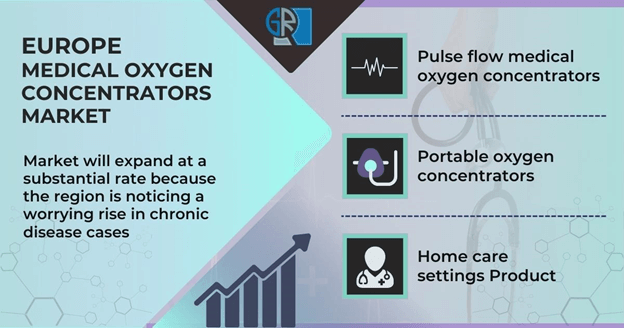Europe medical oxygen concentrators market size will expand at a substantial rate because the region is noticing a worrying rise in chronic disease cases. A vast majority of the population in Europe is aged 65 years and above, increasing their chances of being diagnosed with life-threatening disorders.
According to Eurostat, in 2021, more than 20.8% of the EU population was aged 65 years and above, while the share of the population aged 80+ years will grow from 6% in 2021 to 14.6% by 2100. Cardiovascular disease (CVD) accounts for more than half of all deaths across the region, according to the WHO.
This has amplified the sale of medical oxygen concentrators to offer a stable oxygen supply during and after surgery.

Pulse flow medical oxygen concentrators will gain traction:
Pulse flow medical oxygen concentrators industry will capture a major share of the regional revenue by 2027. These devices are integrated with smart technologies that detect a patient’s breathing pattern and supply oxygen accordingly.
This significantly reduces the wastage of oxygen, offering more control over the oxygen supply, and making the devices more efficient. Pulse dose oxygen concentrators also improve the mobility of patients as they can be moved from one place to the other – an advantage that continuous flow systems do not offer.
Rising incidence of respiratory conditions, including chronic obstructive pulmonary disease, will fuel France medical oxygen concentrators industry forecast. In November 2020, CAIRE’s Freestyle Comfort portable oxygen concentrator was approved for reimbursement across healthcare facilities in Germany and France. This move will help CAIRE expand its product’s access to patients across these nations.
Portable oxygen concentrators are highly preferred by patients:
Europe portable medical oxygen concentrators market size will record an impressive growth rate through 2027. One of the main advantages of these products is that they offer a lot of mobility and freedom to patients and enable them to live a normal life.
Many companies are launching compact and lightweight versions of these devices, making them easier to carry anywhere, including while traveling. Advanced technologies are being introduced in these products to automatically adjust the oxygen supply, thereby enhancing the patient’s convenience.
For example, Inogen recently launched the Inogen One G5, which is a compact and lightweight medical oxygen concentrator. The product offers the most oxygen per pound for any portable concentrator and claims to increase the independence of patients who are reliant on a 24/7 supplementary oxygen supply.
Product use to rise across home care settings:
Since a large percentage of high-income European population falls under the age category of 65 years and above, several of them prefer getting treated from the comfort of their homes. Homecare settings offer great convenience and comfort to elderly patients.
The ‘Discharge to Assess’ model was launched across NHS trusts in England. The initiative aimed to discharge patients from hospitals as soon as doctors felt that they did not need acute care but should be kept under close observation during the recovery phase. Patients will be allowed to avail their regular treatment services from home to shorten the recovery time. Such efforts will fuel the product demand in home settings across the regional market.
U.K. medical oxygen concentrators market share will be fueled by the presence of a strong healthcare system and technological upgrades introduced in these products to enhance their performance and efficiency. ResMed, Invacare Corporation, Inogen, GCE Healthcare, and CAIRE are among the top regional manufacturers of pulse and continuous flow medical oxygen concentrators.


